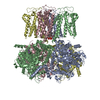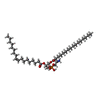+ Open data
Open data
- Basic information
Basic information
| Entry | Database: PDB / ID: 8hkm | |||||||||||||||||||||||||||||||||||||||||||||||||||||||||
|---|---|---|---|---|---|---|---|---|---|---|---|---|---|---|---|---|---|---|---|---|---|---|---|---|---|---|---|---|---|---|---|---|---|---|---|---|---|---|---|---|---|---|---|---|---|---|---|---|---|---|---|---|---|---|---|---|---|---|
| Title | ion channel | |||||||||||||||||||||||||||||||||||||||||||||||||||||||||
 Components Components | Potassium channel subfamily T member 1 | |||||||||||||||||||||||||||||||||||||||||||||||||||||||||
 Keywords Keywords | TRANSPORT PROTEIN / ion channel | |||||||||||||||||||||||||||||||||||||||||||||||||||||||||
| Function / homology |  Function and homology information Function and homology informationintracellular sodium-activated potassium channel activity / outward rectifier potassium channel activity / potassium ion transmembrane transport / protein homotetramerization / metal ion binding / plasma membrane Similarity search - Function | |||||||||||||||||||||||||||||||||||||||||||||||||||||||||
| Biological species |  Homo sapiens (human) Homo sapiens (human) | |||||||||||||||||||||||||||||||||||||||||||||||||||||||||
| Method | ELECTRON MICROSCOPY / single particle reconstruction / cryo EM / Resolution: 2.95 Å | |||||||||||||||||||||||||||||||||||||||||||||||||||||||||
 Authors Authors | Jiang, D.H. / Zhang, J.T. | |||||||||||||||||||||||||||||||||||||||||||||||||||||||||
| Funding support |  China, 1items China, 1items
| |||||||||||||||||||||||||||||||||||||||||||||||||||||||||
 Citation Citation |  Journal: Cell Rep / Year: 2023 Journal: Cell Rep / Year: 2023Title: Structural basis of human Slo2.2 channel gating and modulation. Authors: Jiangtao Zhang / Shiqi Liu / Junping Fan / Rui Yan / Bo Huang / Feng Zhou / Tian Yuan / Jianke Gong / Zhuo Huang / Daohua Jiang /  Abstract: The sodium-activated Slo2.2 channel is abundantly expressed in the brain, playing a critical role in regulating neuronal excitability. The Na-binding site and the underlying mechanisms of Na- ...The sodium-activated Slo2.2 channel is abundantly expressed in the brain, playing a critical role in regulating neuronal excitability. The Na-binding site and the underlying mechanisms of Na-dependent activation remain unclear. Here, we present cryoelectron microscopy (cryo-EM) structures of human Slo2.2 in closed, open, and inhibitor-bound form at resolutions of 2.6-3.2 Å, revealing gating mechanisms of Slo2.2 regulation by cations and a potent inhibitor. The cytoplasmic gating ring domain of the closed Slo2.2 harbors multiple K and Zn sites, which stabilize the channel in the closed conformation. The open Slo2.2 structure reveals at least two Na-sensitive sites where Na binding induces expansion and rotation of the gating ring that opens the inner gate. Furthermore, a potent inhibitor wedges into a pocket formed by pore helix and S6 helix and blocks the pore. Together, our results provide a comprehensive structural framework for the investigation of Slo2.2 channel gating, Na sensation, and inhibition. | |||||||||||||||||||||||||||||||||||||||||||||||||||||||||
| History |
|
- Structure visualization
Structure visualization
| Structure viewer | Molecule:  Molmil Molmil Jmol/JSmol Jmol/JSmol |
|---|
- Downloads & links
Downloads & links
- Download
Download
| PDBx/mmCIF format |  8hkm.cif.gz 8hkm.cif.gz | 734.6 KB | Display |  PDBx/mmCIF format PDBx/mmCIF format |
|---|---|---|---|---|
| PDB format |  pdb8hkm.ent.gz pdb8hkm.ent.gz | 584.3 KB | Display |  PDB format PDB format |
| PDBx/mmJSON format |  8hkm.json.gz 8hkm.json.gz | Tree view |  PDBx/mmJSON format PDBx/mmJSON format | |
| Others |  Other downloads Other downloads |
-Validation report
| Summary document |  8hkm_validation.pdf.gz 8hkm_validation.pdf.gz | 1.6 MB | Display |  wwPDB validaton report wwPDB validaton report |
|---|---|---|---|---|
| Full document |  8hkm_full_validation.pdf.gz 8hkm_full_validation.pdf.gz | 1.7 MB | Display | |
| Data in XML |  8hkm_validation.xml.gz 8hkm_validation.xml.gz | 104.2 KB | Display | |
| Data in CIF |  8hkm_validation.cif.gz 8hkm_validation.cif.gz | 151 KB | Display | |
| Arichive directory |  https://data.pdbj.org/pub/pdb/validation_reports/hk/8hkm https://data.pdbj.org/pub/pdb/validation_reports/hk/8hkm ftp://data.pdbj.org/pub/pdb/validation_reports/hk/8hkm ftp://data.pdbj.org/pub/pdb/validation_reports/hk/8hkm | HTTPS FTP |
-Related structure data
| Related structure data |  34855MC  8hirC  8hk6C  8hkfC  8hkkC  8hkqC M: map data used to model this data C: citing same article ( |
|---|---|
| Similar structure data | Similarity search - Function & homology  F&H Search F&H Search |
- Links
Links
- Assembly
Assembly
| Deposited unit | 
|
|---|---|
| 1 |
|
- Components
Components
| #1: Protein | Mass: 139865.234 Da / Num. of mol.: 4 Source method: isolated from a genetically manipulated source Source: (gene. exp.)  Homo sapiens (human) / Gene: KCNT1 / Production host: Homo sapiens (human) / Gene: KCNT1 / Production host:  Homo sapiens (human) / References: UniProt: Q5JUK3 Homo sapiens (human) / References: UniProt: Q5JUK3#2: Chemical | ChemComp-K / #3: Chemical | ChemComp-ZN / #4: Chemical | ChemComp-6OU / [( Has ligand of interest | Y | Has protein modification | Y | |
|---|
-Experimental details
-Experiment
| Experiment | Method: ELECTRON MICROSCOPY |
|---|---|
| EM experiment | Aggregation state: PARTICLE / 3D reconstruction method: single particle reconstruction |
- Sample preparation
Sample preparation
| Component | Name: ion channel / Type: COMPLEX / Entity ID: #1 / Source: RECOMBINANT |
|---|---|
| Source (natural) | Organism:  Homo sapiens (human) Homo sapiens (human) |
| Source (recombinant) | Organism:  Homo sapiens (human) Homo sapiens (human) |
| Buffer solution | pH: 7.5 |
| Specimen | Embedding applied: NO / Shadowing applied: NO / Staining applied: NO / Vitrification applied: YES |
| Vitrification | Cryogen name: ETHANE |
- Electron microscopy imaging
Electron microscopy imaging
| Experimental equipment |  Model: Titan Krios / Image courtesy: FEI Company |
|---|---|
| Microscopy | Model: FEI TITAN KRIOS |
| Electron gun | Electron source:  FIELD EMISSION GUN / Accelerating voltage: 300 kV / Illumination mode: FLOOD BEAM FIELD EMISSION GUN / Accelerating voltage: 300 kV / Illumination mode: FLOOD BEAM |
| Electron lens | Mode: BRIGHT FIELD / Nominal defocus max: 2200 nm / Nominal defocus min: 1200 nm |
| Image recording | Electron dose: 60 e/Å2 / Film or detector model: GATAN K2 SUMMIT (4k x 4k) |
- Processing
Processing
| Software | Name: PHENIX / Version: 1.20.1_4487: / Classification: refinement | ||||||||||||||||||||||||
|---|---|---|---|---|---|---|---|---|---|---|---|---|---|---|---|---|---|---|---|---|---|---|---|---|---|
| EM software | Name: PHENIX / Category: model refinement | ||||||||||||||||||||||||
| CTF correction | Type: PHASE FLIPPING AND AMPLITUDE CORRECTION | ||||||||||||||||||||||||
| 3D reconstruction | Resolution: 2.95 Å / Resolution method: FSC 0.143 CUT-OFF / Num. of particles: 24190 / Symmetry type: POINT | ||||||||||||||||||||||||
| Refine LS restraints |
|
 Movie
Movie Controller
Controller








 PDBj
PDBj







